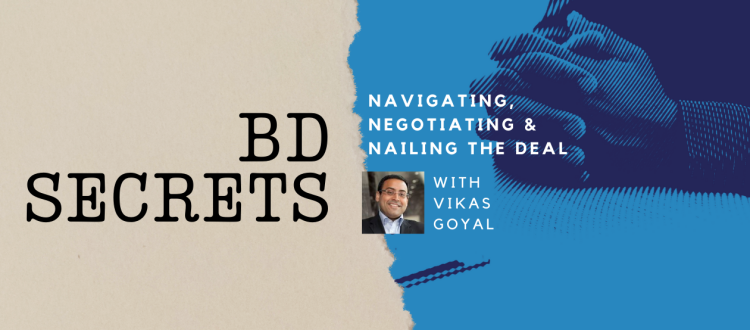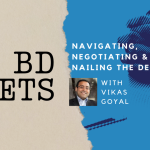Jan Skvarka, former Trillium CEO, on Driving a Turnaround

Vikas Goyal, Managing Partner, Trekk Venture Partners
Jan Skvarka isn’t a household name in biotech. Maybe he should be.
Skvarka was previously the CEO of Trillium Therapeutics, where he led a remarkable turnaround of the Canadian small cap biotech into a leading immune oncology player. Trillium had a market capitalization of $16 million when he started. Over the next two years, he led it to a $2.26 billion acquisition by Pfizer.
The acquisition gave Pfizer access to TTI-622 and TTI-621, two potentially best-in-class CD47 inhibitors now in development for multiple cancer indications, and a team of more than 50 expert drug developers.
Prior to Trillium, Jan had a long career as a strategy consultant at Bain & Co, an experience that would help him in many ways during Trillium. He is currently the executive chairman of DEM Biopharma, and a board member of Zentalis Pharmaceuticals and Monte Rosa Therapeutics.

Jan Skvarka, former CEO, Trillium Therapeutics
Jan spoke with me about why he is so excited about the CD47 mechanism, the situation when he joined Trillium, and how he approached the strategy, culture, and vision for the company.
How did you get involved with Trillium and what was the situation when you arrived?
I have always been fascinated by the success of T cell checkpoint inhibitors. It’s one of the biggest success stories in the history of medicine, delivering cancer cures, winning the Nobel Prize, and soon to be the largest drug class ever.
But, T cell checkpoint inhibitors engage only the adaptive arm of the immune system, and typical response rates are about 20-40 percent. My aspiration was to help create a novel checkpoint inhibitor therapy that would target the innate arm of the immune system, and – ultimately – in combination with T cell checkpoint therapies, to have a complete immunotherapy regimen that engages both arms of the immune system, and would challenge chemotherapy as a frontline approach in cancer
[When I joined Trillium in 2019,] CD47 was arguably the most promising innate immune system checkpoint inhibitor in clinical development. Trillium had two CD47 blockers with promising safety profiles and monotherapy activity.
Importantly, the molecules did not bind red blood cells and hence didn’t cause anemia, a major potential liability with some of the other CD47 targeted approaches in development. Trillium’s lead molecule also had stellar monotherapy activity, with over 90 percent of cutaneous T cell lymphoma (CTCL) patients showing lesion improvement within three weeks of treatment in an ongoing Phase 1 study.
Trillium had a great core executive team in Canada, comprised of CSO Bob Uger, CTO Penka Petrova and CFO James Parsons. They were highly capable in their respective functions, smart, loyal and dedicated.
But the company was facing numerous challenges.
One, the company’s lead program was intratumoral treatment of CTCL. Neither the delivery route nor the indication had any commercial legs. So this was an ironic situation — the clinical data was incredibly strong, but strategically the program had little commercial potential, and as such no appeal to partners or investors.
Operationally, the phase 1 study was stuck in its fifth year of crawling patient enrollment.
On the financial side, the stock price was down from a high of $30 to $0.40 per share. There was almost a complete exodus of quality investors save for NEA. We were only a few months of cash away from hitting Going Concern, and the company was about to be delisted from NASDAQ.
Nevertheless, the scientific foundation was there. And with this foundation, and the core executive team, I felt we had a shot at rebuilding.
What was your plan?
Given the challenging situation, I spent about six months on a diligence of the underlying science and Trillium’s assets. I wanted to be sure my conviction in the scientific foundation was solid.
I also wanted to be sure I was aligned with the board on what to do.
So I wrote a memo before I joined, outlining: (1) my analysis of the situation, (2) strategic options, and (3) plan and hypothesis for how to proceed. I presented the memo to chairman Bob Kirkman and, with his support, spoke to every member of Trillium’s Board. Once we had alignment, I was in.
It would end up being a two-year journey which I describe in three stages.
Stage one I’ll call the Emergency Room, stage two was Transformation, and stage three was The Build Out.
Stage one, the Emergency Room, took the first three months – the fourth quarter of 2019. We approached the situation like a patient in an ER, when you have to stop the bleeding. First, to address the cash burn, we had to lay off 40 percent of the staff. Second, we had a complete reset of strategy — we discontinued the lead intratumoral CTCL program and refocused on the intravenous route while prioritizing larger hematologic indications and solid tumors.
We also decided to resurrect the backup molecule, TTI-622, which would eventually become the molecule that drove Pfizer’s interest. By the way, I also believe that this decisiveness and speed helped us later rebuild investor confidence.
Stage two, the Transformation, took about 15 months, spanning 2020 and the first quarter of 2021. It was a lot of systematic blocking and tackling, touching every single aspect of the company.
On the people side, six out of eight board members and five out of eight executive team members, including myself, joined as part of the turnaround. We created a world class SAB and six indication-specific Key Opinion Leader panels.
We moved the headquarters from Canada to the US (Cambridge, Mass.), and transitioned from a foreign to a domestic filer. We raised $300 million across two rounds. We secured an equity deal with Pfizer for $25 million and added their chief scientific officer of oncology, Jeff Settleman, to our scientific advisory board.
At the first signs of COVID, we bought two years of manufacturing capacity in advance, a critical decision that helped us execute clinical studies without any delays.
On the clinical development side, we accelerated patient enrollment despite COVID, completed Phase 1 studies, declared recommended Phase 2 doses, and – critically – showed best-in-class monotherapy activity with intravenous delivery, and strong tox profiles.
We also did a lot of work in the trenches with investors. This was a turnaround and we needed to rebuild confidence. We had over 400 investor meetings in 2020! We recruited Paul Walker and Ali Behbahani from NEA to our board, which sent a strong signal to the investor community. And even with magrolimab’s good data at ASH 2019, it was only with our significant effort to communicate our new strategy that we got any read-through benefit.
In April 2021, we entered Stage three, The Build-out. With money in the bank, board and executive teams in place, and two molecules with class-leading monotherapy activity, we launched a broad Phase 2 program with nine clinical studies across multiple indications in both hematologic malignancies and solid tumors, while doubling the size of the organization within the next year.
Why did Trillium want Pfizer as an investor and how did that relationship evolve?
The initial $25 million Pfizer investment was not about the money – it was about validating our work, building relationships, and getting access to Jeff’s expertise.
Let me step back to January 2020, just as we exited the “ER”. At that time, we announced a new strategy transitioning TTI-621 from intratumoral to intravenous delivery, and from CTCL to larger hematological malignancies.
A few months later that year, our back-up program TTI-622 started showing strong monotherapy activity with a very good tox profile, while TTI-621 was experiencing thrombocytopenia issues. We made a strategic decision to transition the strategy a second time, making TTI-622 our new lead program while deprioritizing TTI-621. I was worried about how this new transition would be perceived by investors.
The Pfizer equity investment gave us an important validation for the shift to TTI-622. On Sept. 8, 2020, at 4 pm, we announced the new data for TTI-622. Two hours later, at 6pm, we announced the Pfizer deal. The day after, we announced we were going to do a public fundraising offering. Then on Sept. 10, we closed the round for $150 million.
At this time, with Phase 1 studies of both TTI-621 and 622 ongoing, we weren’t looking for a partner. We were in a great place to continue building the data and building the company, and we had high confidence in our assets. However, come May 2021 and the stock price started coming down, partly due to the markets getting nervous about biotech, and partly due to some retail investors selling out of their Trillium positions.
I approached John DeYoung, Pfizer’s head of business development for oncology, to ask if Pfizer would consider another $25 million equity investment, given that we had generated [substantial additional] Phase 1 data since Pfizer’s initial investment in September 2020. John said “let us have a look at the data” and Pfizer started the diligence. While they were looking at the updated Phase 1 results, Phase 2 data started coming in, including from some very tough multiple myeloma and AML patients, two indications of strategic interest to Pfizer.
It was at this point that Pfizer shifted their interest from a simple equity investment to a full buy-out.
How did you manage the culture through all those changes?
I’m not a believer in lengthy meetings about culture and putting lots of buzzwords on the wall. Buzzwords are cheap – after all, even Enron had “Integrity” engraved on their headquarters entrance wall. I think culture is shaped organically through how we make decisions, who we recruit, and how we treat employees. It has to be with respect, transparency and honesty, while always keeping patient impact in mind.
It is critical to have a vision and be crystal clear about the company’s direction. And not just clarity about who you are. It’s also equally important to be clear about who you are not. Without this clarity, companies and executives get distracted, they get pulled in different directions.
The toughest part of my time at Trillium was Stage one, the emergency room. Turnaround situations require decisive leadership and speed. There is no room for hesitation. You cannot procrastinate. Maybe you can still pay severances if you move today, but if you prolong things six months the company could run out of cash. And the team is deflated and maybe considering moving on to other opportunities – so staff are already anxious to hear where we are heading. So, we did these changes with speed, balanced with respect and transparency.
It was this respect and transparency with our staff that allowed us to rehire several laid-off employees once we were stabilized.
What were some of the keys to your successful relationship with Pfizer?
Trust is key. Don’t oversell, always be honest and transparent. In our case, Pfizer had about 150 people on the due diligence, and they turned over every stone. So, if there are any problems, just be transparent about them, disclose them upfront, as you don’t want them to come up later in the diligence and then play defense.
Relationships have been important to your success. Can you talk about some that have been pivotal for you?
That’s a great question. I believe there are two parts to it – relationships that contributed to our success at Trillium, and relationships that were formative to who I am as a person and an executive.
On the Trillium part, we had a truly outstanding team. In addition to my Canadian executives who I mentioned before, we later added Ingmar Bruns, a talented, brilliant chief medical officer; Lisa Fiering, an excellent human resources executive; Ben Looker, an outstanding general counsel; and Rose Harrison who thoughtfully led our strategy efforts.
Paolo Pucci, our lead director, masterfully guided the board through its M&A considerations and was always there for me as a great coach and mentor. Jason Fenton of Cowen (now with Oppenheimer) played a critical role in our fundraising efforts, especially at a time when no other banker would have touched Trillium. Eric Tokat of Centerview was much more than just our M&A banker – he was also a true advisor who guided several of our major strategy and BD decisions even before we were an actual M&A candidate.
I would be remiss not to mention also the Pfizer oncology leadership team – Jeff Settleman, Oncology CSO, who as our SAB member greatly contributed to some of our most critical clinical development decisions; Chris Boshoff, oncology chief development officer, who did a phenomenal job at pre-merger integration and squarely deserves the credit for achieving a 100 percent acceptance rate of the Trillium staff who were offered to continue with Pfizer after the acquisition; and John DeYoung, oncology BD head, a master communicator and someone who just gets things done.
Beyond Trillium, I have been incredibly lucky to have great mentors who took personal interest in me, helped me grow as an executive, and navigated me in many tricky situations. In particular, I owe enormous debt to three people who I worked with as a CEO of Tal Medical prior to Trillium – Steve Paul, Tal co-founder and Board chair, former head of R&D at Lilly, who coached me in my transition from a Bain consultant to a life sciences CEO; John Abele, Tal senior advisor, co-founder and former chair of Boston Scientific, who taught me how to build industry relationships and manage people; and Bob Langer, co-founder of Tal’s parent company PureTech and MIT professor, who helped me navigate several complex business and career situations.
Last but not least, I’d like to mention Chuck Farkas, senior partner at Bain & Company, under whose thoughtful mentorship I grew from a fresh MBA grad to one of the lead life sciences partners at Bain. It is my aspiration to help other life sciences executives by passing on the knowledge I learned from these great individuals.





